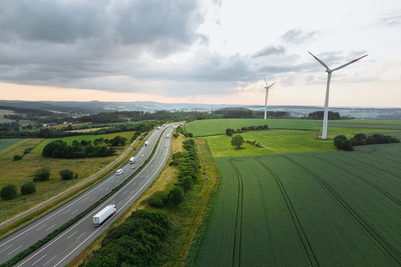article
July 20, 2023
When Hydrogen Becomes a Geopolitical Imperative for France
COP28 made its mark by reaching a consensus on the "call to transition away from fossil fuels", which was accompanied by a call from more than 30 countries to accelerate the development of hydrogen as a means of distributing green energy around the world. Hydrogen is set to account for almost 15% of final energy demand in the coming decades. What does this mean for France? For Europe?

When Hydrogen Becomes a Geopolitical Imperative for France
Today, fossil energies are the primary energy source in Europe. Oil and its derivatives, gas, and coal represent more than 65% (75% in 2021) 1 of overall energy consumption. In addition to contributing to climate change, these fossil energies do not allow Europe to secure its energy independence: in 2020, even before Russia’s invasion of Ukraine, 96% of oil supplies came from imports (26% of which came from Russia, though this has since gone under 5%), 84% of natural gas was imported (43% from Russia, now below 15%), and 36% coal (out of which around 50% come from Russia). In 2023, EU countries’ energy reliance on imports of fossil resources will still be significant and should represent more than 90% of oil resources and above 80% of natural gas resources are imported. The suspension of fossil fuel imports from Russia was compensated for by increased imports from the United States, Norway and the United Kingdom, with a particular increase in liquefied natural gas imports 2 .
The challenge of moving away from fossil fuel consumption is therefore threefold: energy sovereignty, decarbonization and sustainability. Using hydrogen has been clearly identified as indispensable for meeting sustainability objectives. Indeed, large sectors of the economy cannot be electrified, and require a substitute for fossil fuels in liquid and gas form, for uses that electricity (and batteries) cannot efficiently support. The global hydrogen market is already a reality as it currently represents more than €100 billion and 80 million tons 3 (MT), mainly for the refining and production of fertilizers. In this sense, hydrogen has many advantages, as it can help to decarbonize energy-intensive industries — by replacing, alone or in derivatives forms, natural gas, coal and oil — as well as intensive, heavy-duty transportation in cases where battery-powered electrification is too cumbersome (2.5 to 3 times more), too heavy (increasingly so as the load increases) and too long to recharge (a few minutes versus tens of minutes or a few hours). Hydrogen also allows Europe to increase its energy sovereignty and to partially reuse existing gas (or oil) infrastructure. It enables us to take advantage of the wide availability of renewable resources and property in certain regions of the world, and to import them into countries with strong demand (Europe, Japan, Korea, etc.), in the form of hydrogen or its derivatives (ammonia and methanol for example), thereby broadening our sources of supply and strengthening our ability to develop energy’s “friend-shoring” moves. In this respect, strategic choices concerning the evolution of our energy mix, and in particular the hydrogen component, are becoming new geopolitical levers, clearly identified as such by our major European partners and the North-East Asian region.
This substitution by hydrogen (and its derivatives) and electricity the electron of our fossil fuels is a systemic one as it offers a path towards a functional, low-carbon energy model. This paradigm shift requires us to act now — on production, usage, and distribution infrastructure — in order to allow this shift over the next two decades. Between now and 2050, the trajectory of European energy independence could mean using 40 to 60 MT 4 of hydrogen, with 2 to 4 MT for France alone (2 to 6 times that of current consumption), according to predictions by the European Commission.
Russia’s invasion of Ukraine revealed the weaknesses inherent in the European Union’s energy model. This is why, starting in May 2022, the European Commission proposed a plan whose objective is to put an end to our dependence on Russian hydrocarbons before 2030 and to achieve carbon neutrality by 2050. In order to meet that objective, REPowerEU intends to act on several fronts: energy conservation, diversifying supply sources, accelerating the rollout of renewable energies, and reducing fossil energy consumption in industry and transportation. This plan includes accelerating European hydrogen production and establishing import strategies with our partners in the Mediterranean region (pipelines) and beyond (ammonia). The Commission’s plan aims to use 20 MT of low-carbon hydrogen by 2030, from both European production (50%) and imports (50%). These 20 MT of renewable hydrogen will replace, depending on use, between 25 and 50 billion m3 of natural gas 5 (between 10-15% of the natural gas consumed in Europe). Even if its agenda remains optimistic, this ambition is bolstered by the energy, geopolitical, and climate context.
The development of a multi-source strategy for accessing hydrogen resources seems to be a sustainable way of strengthening European and French energy sovereignty, and preserving the competitiveness of the old continent’s energy-intensive industries. Beyond the raising of awareness, this strategy’s success depends on strong, decisive decisions. It will also enable us to re-deepen our strategic dialogue with some of the major countries in the Mediterranean region and the Middle East.
Producing decarbonized hydrogen in Europe and France
The ability to produce 10 MT of hydrogen on European soil by 2030 requires the construction and installation of 100 GW 6 of electrolysis capacity as well as extensive use of renewable and nuclear energies in order to guarantee hydrogen’s sustainability, which can only be done by overcoming numerous challenges.
Large-scale production of electrolyzers is the first obstacle to developing a strong and autonomous European industry. Planning the rollout of electrolyzer manufacturing sites with a total capacity of 20 GW/year, equivalent to a 10-fold increase in manufacturing capacity by 2025 is already in the works. At the same time, in order to support supply, electrolytic hydrogen production capacity will need to be doubled every year until 2030, assuming we have already reached 2 GW of installed capacity by 2024. Achieving this objective has long been dependent on IPCEI (Important Project of Common European Interest) decisions, whose validation procedures and national iterations have taken a very long time in these initial phases 7 . In order to win this race, France can take the lead in strengthening support for the most ambitious “giga factory” projects. Alongside planned investment support, financing could take the form of guaranteed access to CCFDs 8 in order to give a competitive advantage to actors who decide to establish production sites in France.
European regulation remains unclear as to the transformation of existing hydrogen production, even if it does foresee a switch to decarbonized hydrogen for future industrial needs or sustainable transport fuels. It could be strengthened by national regulations which, as part of a clear timetable, would make the operation of natural gas-based hydrogen production units conditional on the operational implementation of the necessary carbon capture and storage projects. For operations moving towards electrolysis technologies, support mechanisms in the form of multi-year contracts which, over the first 10 years of operation of the first large-scale units installed (100 MW or more), cover all or part of the extra cost of green hydrogen as compared with grey hydrogen, using a mechanism indexed to a rising price of avoided CO2 9 , are clearly vital. Such mechanisms, which are currently being discussed, are in fine similar to the one put in place in the United States (IRA) in their effects and could be even more easily limited in terms of financial burden for public authorities, as long as European and national regulations are simultaneously forcing the switch to a green or low-carbon hydrogen benchmark.

Report: Hydrogen Internal Combustion Engines in Europe’s Road Mobility Decarbonisation
The development of this report was led by members of the H2Accelerate collaboration which has been formed by major players from the fuel supply and trucking industries to work together to accelerate the deployment of hydrogen - powered trucking in Europe.
More about

“Fuel Cell Technology has now reached unprecedented performance”: Recent Advances Reinforce the Case for Hydrogen Mobility
An interview with Sae Hoon Kim, engineer, leader of Hyundai’s hydrogen strategy and Head of Fuel Cell Development for 20 years.
More about

Innovating to finance the hydrogen economy
On the road to a more sustainable economy, we need more investment in sustainable assets. These investments must not only be supported by appropriate regulatory frameworks, but also encouraged and facilitated by financial mechanisms.
More about
